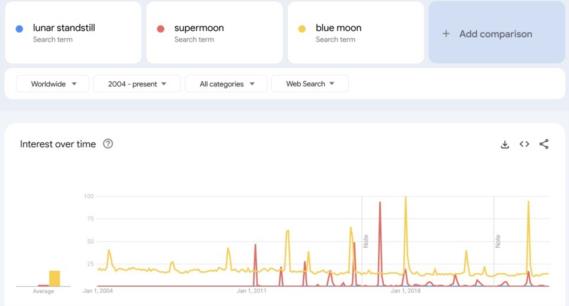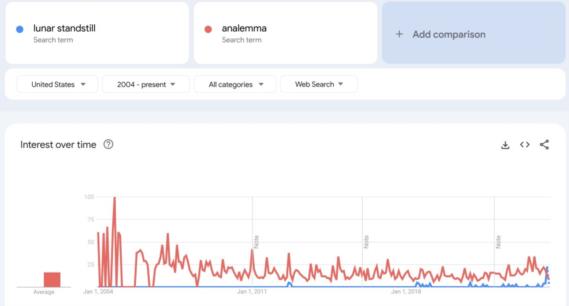
NavList:
A Community Devoted to the Preservation and Practice of Celestial Navigation and Other Methods of Traditional Wayfinding
From: Frank Reed
Date: 2024 Jul 19, 05:53 -0700
It's a term from "archeoastronomy", which became narrowly popular in that small and idiosyncratic subject starting in the 1990s. The Wikipedia article strikes me as a "private project" of a few Wiki-editors (reminder: that's not a job... anyone can be a Wiki-editor!), and the length of the article is grossly mis-matched with the very low importance of the topic and usage of the term. The phrase "lunar standstill" has very little traction outside that field of archeoastronomy and barely registers in Google searches. In the first graphic below, created with "Google Trends", I'm comparing "lunar standstill" and "supermoon" and "blue moon". Lunar standstill is next to nothing. I tried various other terms and eventually found that I could get "lunar standstill" to show up when compared against the relatively rare (but much more common) term "analemma", as in the second graphic. There's a plainly visible recent "blip".
Whether this latest online "celebration" is enough to bring the term into any sort of long-lasting popular consciousness, as happened previously with "blue moon" and "super moon"... well, we'll just have to wait and see. I suspect an 18-year recurrence period is too long! But Moon terms are popular in the modern world. The Sun and Moon and sometimes Venus and Jupiter are now the only astronomical objects readily visible to the vast majority (>95%) of the world's population. That's a tragedy. And yet even more amazing is the suggestion that we should "watch" this "lunar standstill" via an online video feed from Hollywood! Seeing is believing, as long as it's streaming online, I suppose.
Two weeks ago a woman who I estimated to be about 75 years old explained to me that she was determined to see the Milky Way. She had never seen it in her entire life (or doesn't remember having seen it, more likely), and it was on her "bucket list". She presently lives in Nashua, New Hampshire. I told her she could drive 15 or 20 miles west of the city and find a dark park, without much difficulty (but bring a few friends for safety). Then she said to me, "I'll go at Full Moon to make it even more beautiful". Thank the Ophiuchans she said that aloud! I then explained that a date from four or five days after Full Moon through a couple of days after New Moon, starting at least an hour after sunset was the time to see the summer Milky Way in all its glory. The Full Moon would wipe it out. She said she had no idea that this would be the case. I wonder if she'll be disappointed to discover that it doesn't look like the social media photos... :/
Frank Reed
Clockwork Mapping / ReedNavigation.com
Conanicut Island USA








